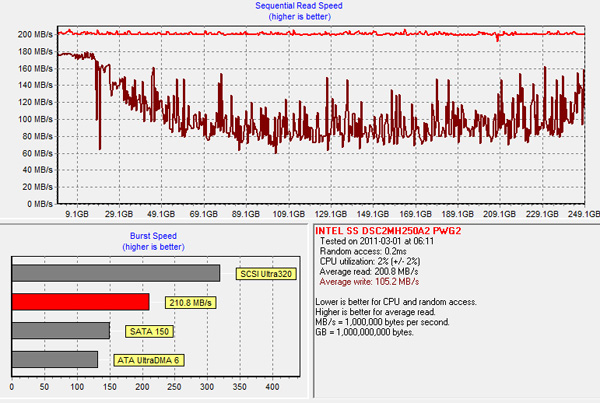The Intel SSD 510 Review
by Anand Lal Shimpi on March 2, 2011 1:23 AM EST- Posted in
- IT Computing
- Storage
- SSDs
- Intel
- Intel SSD 510
TRIM Performance
As expected, Intel's SSD 510 fully supports the ATA TRIM instruction. To gauge it's implementation I filled the 510 with data then ran a 4KB random write test (QD=32, 100% LBA space) for 20 minutes and measured performance using ATTO. I then TRIMed the entire drive by formatting it in Windows 7 and re-ran the ATTO test. The graphs below show clean, torture and and after TRIM performance.
First clean performance:

Next, after our torture session:

Once tortured the 510's performance drops as far down as 60MB/s for writes. A single TRIM pass restores performance to an almost-new state:

Worst case sequential performance isn't terrible, but worst case random write performance is pretty bad. Remember the ~50MB/s speeds from earlier? Those will drop down to ~5MB/s with an adequately fragmented drive. TRIM will recover performance but write amplification goes through the roof if you have a highly random workload. The 510 is suitable for desktop workloads, but anything more enterprise-like may be out of the question (at least not without significantly increasing the amount of spare area). I'm currently testing the 510 in a Mac to see how performance fares without TRIM over time.










128 Comments
View All Comments
deadsmeat - Wednesday, March 2, 2011 - link
I am not sure if I missed it, but will you do a price/performance for SSDs? For example, and Intel or Corsair SSD migth be the fastest, but if it has a good price/performance vs the fastest SSD then it's something that consumers might consider when getting an SSD.I don't have a clear "performance" since you have run many benchmark in there, but something like a "real world load" would be good to see. I may not want the fastest SSD, but I will be looking for something that has good over-all balance in performance, and not so heavy on the pocket...
deadsmeat - Wednesday, March 2, 2011 - link
Woops, I missed "not" i.e.Intel or Corsair SSD might NOT be the fastest, but if it has a good price/performance vs the fastest SSD then it's something that consumers might consider when getting an SSD.
dagamer34 - Wednesday, March 2, 2011 - link
I thought that's what the light benchmark was, more "normal" tasks that aren't super-abusive with the SSD.vol7ron - Wednesday, March 2, 2011 - link
Yes, light being "AnandTech Storage Bench 2011 - Light Workload".Either Light or Heavy depending on your use seems to be a combination of both random and sequential performance.
As stated in the article:
"I'll be sharing the full details of the benchmark in some upcoming SSD articles but here are some details:
1) The MOASB, officially called AnandTech Storage Bench 2011 - Heavy Workload, mainly focuses on the times when your I/O activity is the highest. There is a lot of downloading and application installing that happens during the course of this test. My thinking was that it's during application installs, file copies, downloading and multitasking with all of this that you can really notice performance differences between drives.
2) I tried to cover as many bases as possible with the software I incorporated into this test. There's a lot of photo editing in Photoshop, HTML editing in Dreamweaver, web browsing, game playing/level loading (Starcraft II & WoW are both a part of the test) as well as general use stuff (application installing, virus scanning). I included a large amount of email downloading, document creation and editing as well. To top it all off I even use Visual Studio 2008 to build Chromium during the test."
therealnickdanger - Wednesday, March 2, 2011 - link
What price would you use? MSRP? Newegg after MIR? Just pick a usage scenario that fits your usage and divide the score by the dollar amount of your favorite e-tailer... Pretty simple.vol7ron - Wednesday, March 2, 2011 - link
Why not have both? AT has used a price grabber in the past.Actually, where did that go? It started to break down on the old site, but I'd like to see AT put that part shopper back up.
MrDiSante - Wednesday, March 2, 2011 - link
Realistically speaking, if you're buying computer components/peripherals, the functionRetailer GetLowestPrice(Component component)
{
return Newegg;
}
would probably be better than the average price comparison site.
marraco - Wednesday, March 2, 2011 - link
To be useful, the comparison needs to consider RAID 0 setups.dagamer34 - Wednesday, March 2, 2011 - link
It seems like the one true major difference between the Intel SSD 510 and the OCZ Vertex 3 is that one is available now while the other is only talked about in reviews. First to market is always a benefit for a manufacturer that has a decently performing product, though Newegg's markup makes early adopter's pay dearly for it.Of course, this leads to the important question of "when will the Vertex 3 series reach general availability?" I recently purchased a 120GB OCZ Vertex 2 for a new 2011 17" MacBook Pro and the performance is stunning compared to the stock HDD (it's my first SSD). I'm wondering if I should return the drive and just wait for the Vertex 3 because once you've gone SSD, it is so hard to go back!
Thanks for the review Anand!
dagamer34 - Wednesday, March 2, 2011 - link
Oh, another thing. Are we going to get an SSD State of the Union for 2011? I'm guessing you're waiting to finish the reviews of most of the SSDs that are coming out this year first... Yeah, I just answered my own question, I think. :)